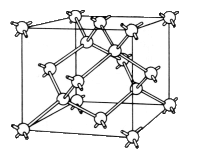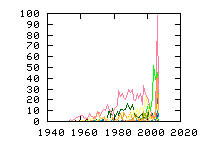« Previous
1
Next »
(25 hits, 1/1)
Showing
10, 25, 50, 100, 500, 1000, all papers per page.
Sort by:
last publication date,
older publication date,
last update date.
- 1. Appl. Phys. Lett. 88, 253504 (2006) , “Single silicon vacancy-oxygen complex defect and variable retention time phenomenon in dynamic random access memories”, T. Umeda, K. Okonogi, K. Ohyu, S. Tsukada, K. Hamada, S. Fujieda, and Y. MochizukiThe variable retention time phenomenon has recently been highlighted as an important issue in dynamic random access memory (DRAM) technology. Based on electrically detected magnetic resonance and simulation studies, we suggest that a single Si vacancy-oxygen complex defect is responsible for this... (Read more)
- 2. J. Appl. Phys. 100, 113725 (2006) , “Light- and bias-induced metastabilities in Cu(In,Ga)Se2 based solar cells caused by the (VSe-VCu) vacancy complex”, Stephan Lany and Alex ZungerWe investigate theoretically light- and bias-induced metastabilities in Cu(In,Ga)Se2 (CIGS) based solar cells, suggesting the Se–Cu divacancy complex (VSe-VCu) as the source of this hitherto puzzling phenomena. Due to its amphoteric nature, the... (Read more)
- 3. J. Appl. Phys. 100, 023704 (2006) , “Transformation behavior of room-temperature-stable metastable defects in hydrogen-implanted n-type silicon studied by isothermal deep-level transient spectroscopy”, Yutaka TokudaIsothermal deep-level transient spectroscopy (DLTS) with a single pulse has been used to study the transformation behavior of hydrogen-related metastable defects labeled EM1 (Ec–0.28 eV) and EM2 (Ec–0.37 eV), which are observed in... (Read more)
- 4. J. Appl. Phys. 99, 063509 (2006) , “On the origin of the Staebler-Wronski effect”, Thomas KrügerThe parametrization of our recently proposed model of the Staebler-Wronski effect (SWE) is improved, which leads to an even better agreement with the experimental photoconductivity of light-soaked a-Si:H. The numerical solution of the essential equation exhibits well the typical SWE behavior,... (Read more)
- 5. Phys. Rev. B 74, 085201 (2006) , “Hydrogen dynamics and light-induced structural changes in hydrogenated amorphous silicon”, T. A. Abtew and D. A. DraboldWe use accurate first-principles methods to study the network dynamics of hydrogenated amorphous silicon, including the motion of hydrogen. In addition to studies of atomic dynamics in the electronic ground state, we also adopt a simple procedure to track the H dynamics in light-excited states.... (Read more)
- 6. Phys. Rev. B 74, 033309 (2006) , “Effect of the triplet state on the random telegraph signal in Si n-MOSFETs”, Enrico Prati, Marco Fanciulli, Giorgio Ferrari, and Marco SampietroWe report on the static magnetic field dependence of the random telegraph signal in a submicrometer silicon n-metal-oxide-semiconductor field-effect transistor. Using intense magnetic fields and low temperatures, we find that the characteristic time ratio changes by three orders of magnitude... (Read more)
- 7. Phys. Rev. B 73, 245210 (2006) , “First-principles investigation of a bistable boron-oxygen interstitial pair in Si”, A. Carvalho, R. Jones, M. Sanati, S. K. Estreicher, J. Coutinho, and P. R. BriddonLocal density functional calculations are used to predict and compare the properties of the two distinct interstitial boron-interstitial oxygen (BiOi) complexes recently reported in the literature. The electronic and free energies, as well as the small... (Read more)
- 8. Phys. Rev. B 73, 033204 (2006) , “Electrical characterization of metastable carbon clusters in SiC: A theoretical study”, A. Gali, N. T. Son, E. JanznFirst-principles calculations carried out in 3C- and 4H-SiC show that small metastable carbon clusters can be created in irradiated SiC. The metastable carbon clusters possess occupation levels in the p-type as well as in the n-type 4H-SiC. Depending on the... (Read more)
- 9. Phys. Rev. Lett. 97, 256602 (2006) , “Bistability-Mediated Carrier Recombination at Light-Induced Boron-Oxygen Complexes in Silicon”, Mao-Hua Du, Howard M. Branz, Richard S. Crandall, and S. B. ZhangA first-principles study of the BO2 complex in B-doped Czochralski Si reveals a defect-bistability-mediated carrier recombination mechanism, which contrasts with the standard fixed-level Shockley-Read-Hall model of recombination. An O2 dimer distant from B causes only weak... (Read more)
- 10. Phys. Rev. Lett. 96, 145501 (2006) , “Identification of the Carbon Antisite-Vacancy Pair in 4H-SiC”, T. Umeda, N. T. Son, J. Isoya, E. Janzn, T. Ohshima, N. Morishita, H. Itoh, A. Gali, M. BockstedteThe metastability of vacancies was theoretically predicted for several compound semiconductors alongside their transformation into the antisite-vacancy pair counterpart; however, no experiment to date has unambiguously confirmed the existence of antisite-vacancy pairs. Using electron paramagnetic resonance and first principles calculations we identify the SI5 center as the carbon antisite-vacancy pair in the negative charge state (CSiVC-) in 4H-SiC. We suggest that this defect is a strong carrier-compensating center in n-type or high-purity semi-insulating SiC. (Read more)SiC| ENDOR EPR Theory electron-irradiation optical-spectroscopy thermal-meas./anneal-exp.| -1 -2 1.0eV~ 13C 29Si C1h C3v Carbon Csi EI5/6 HEI1 HEI5/6 Nitrogen P6/7 SI5 Silicon Vc antisite bistable/metastable dangling-bond n-type pair(=2) semi-insulating vacancy .inp files: SiC/SI5_C1h SiC/SI5_80K SiC/SI5_100K | last update: Takashi Fukushima
- 11. Appl. Phys. Lett. 87, 252118 (2005) , “"EL2" revisited: Observation of metastable and stable energy levels of EL2 in semi-insulating GaAs”, D. Kabiraj, S. GhoshBy using a combination of detailed experimental studies, we identify the metastable and stable energy levels of EL2 in semi-insulating GaAs. These results are discussed in light of the recently proposed models for EL2 in GaAs. ©2005 American Institute of Physics ... (Read more)
- 12. Appl. Phys. Lett. 84, 1704 (2004) , “Bistable defect in mega-electron-volt proton implanted 4H silicon carbide”, D. M. Martin, H. Kortegaard Nielsen, P. L?v?que, A. Hall?n, G. Alfieri, B. G. SvenssonEpitaxial 4H-SiC n-type layers implanted at room temperature with a low fluence of mega-electron-volt protons have been measured by deep level transient spectroscopy (DLTS). The proton fluence of 1×1012 cm–2 creates an estimated initial concentration of... (Read more)
- 13. Physica B 340-342, 743 (2003) , “Annealing study of a bistable defect in proton-implanted n-type 4H-SiC”, H. Kortegaard Nielsen, D. M. Martin, P. Lévêque, A. Hallén and B. G. SvenssonThe thermal stability and annealing kinetics of a bistable defect, recently reported by Martin (Master Thesis, KTH/ELE/FTE/2003-1) employing deep level transient spectroscopy and labelled the M-centre, has been studied using n-type epitaxially grown 4H-SiC layers implanted with 2.5 MeV protons to a... (Read more)
- 14. Appl. Phys. Lett. 81, 1818 (2002) , “Interface structures generated by negative-bias temperature instability in Si/SiO2 and Si/SiOxNy interfaces”, J. Ushio, T. Maruizumi, K. Kushida-AbdelghafarWe used a density functional method to investigate the mechanism of negative-bias temperature instability (NBTI) and resultant structural changes of Si/SiO2 and Si/SiOxNy interfaces. The reaction energies for the water- and hydrogen-originated... (Read more)
- 15. Phys. Rev. Lett. 88, 205502 (2002) , “Metastability of Amorphous Silicon from Silicon Network Rebonding”, R. Biswas, B. C. Pan, and Y. Y. YeWe propose a network rebonding model for light-induced metastability in amorphous silicon, involving bonding rearrangements of silicon and hydrogen atoms. Nonradiative recombination breaks weak silicon bonds and generates dangling bond?floating bond pairs, with very low activation energies. The... (Read more)
- 16. Mater. Sci. Eng. B 58, 171-178 (1999) , “Self-Interstitial Related Reactions in Silicon Irradiated by Light Ions”, B. N. Mukashev, Kh. A. Abdullin, Yu. V. Gorelkinskii and S. Zh. TokmoldinRecent deep level transient spectroscopy (DLTS), electron paramagnetic resonance (EPR) and infrared (IR) spectroscopy data on interactions of self-interstitial with carbon, aluminium, oxygen and hydrogen in silicon irradiated by light ions are reviewed. Self-interstitial behaviour in silicon was... (Read more)
- 17. Phys. Rev. B 58, 9845 (1998) , “Theory of Carbon-Carbon Pairs in Silicon”, R. B. Capaz, A. Dal Pino, Jr., J. D. Joannopoulos.Interstitial-substitutional carbon pairs (CiCs) in silicon display interesting metastable behavior associated with two different structural configurations. In this work, we perform extensive ab initio calculations on this system. Our results show the following. (i) The... (Read more)
- 18. phys. stat. sol. (a) 168, 73 (1998) , “Self-Interstitials in Silicon Irradiated with Light Ions”, B. N. Mukashev, Kh. A. Abdullin, Yu. V. Gorelkinskii.The behavior of self-interstitials in silicon which was irradiated with light ions (protons and -particles) and electrons was explored by monitoring known impurity interstitial centers (Ci, Ali, (Si-O)i) with deep level transient spectroscopy (DLTS) and electron... (Read more)
- 19. Phys. Rev. B 55, 2188-2194 (1997) , “Dynamic Properties of Interstitial Carbon and Carbon-Carbon Pair Defects in Silicon”, P. Leary, R. Jones, S. ?berg, V. J. B. Torres.Interstitial carbon, Ci, defects in Si exhibit a number of unexplained features. The Ci defect in the neutral charge state gives rise to two almost degenerate vibrational modes at 920 and 931 cm-1 whose 2:1 absorption intensity ratio naturally suggests a trigonal... (Read more)
- 20. Mater. Sci. Eng. B 36, 77 (1996) , “New Oxygen-Related EPR Spectra in Proton-Irradiated Silicon”, Kh. A. Abdullin, B. N. Mukashev, A. M. Makhov and Yu. V. GorelkinskiiAn electron-paramagnetic resonance (EPR) study of proton-irradiated silicon has revealed two new EPR spectra labeled Si-AA13 and Si-AA14. Spectrum AA13 has C3v symmetry (g = 1.9985 and g = 2.0024 ± 0.0002), AA14 C1 symmetry. These spectra correspond to positive (B+) and negative (B−)... (Read more)
- 21. Semicond. Sci. Technol. 11, 1696-1703 (1996) , “Metastable oxygen - silicon interstitial complex in crystalline silicon”, Kh. A. Abdullin, B. N. Mukashev, Yu. V. Gorelkinskii.A new metastable complex in monocrystalline silicon irradiated at with protons has been studied. Electron paramagnetic resonance (EPR) Si-AA13 ( symmetry) and Si-AA14 ( symmetry) spectra as well as the known Si-A18 spectrum originate from different molecular configurations of the complex. A... (Read more)
- 22. Phys. Rev. B 47, 6363-6380 (1993) , “Electron paramagnetic resonance of multistable interstitial-carbonsubstitutional-group-V-atom pairs in silicon”, X. D. Zhan, G. D. WatkinsA total of five new electron paramagnetic resonance (EPR) centers are observed in electron-irradiated P-, As-, and Sb-doped silicon. Three are identified as arising from the neutral charge state of the stable configuration and two of the four metastable configurations of an... (Read more)
- 23. Phys. Rev. B 42, 5765 (1990) , “Bistable interstitial-carbonsubstitutional-carbon pair in silicon”, L. W. Song, X. D. Zhan, B. W. Benson, and G. D. WatkinsA bistable interstitial-carbon?substitutional-carbon pair has been identified in electron-irradiated silicon by a combination of several spectroscopic experimental techniques. In the positive and negative charge states, the stable configuration of the defect involves a carbon-silicon ??molecule??... (Read more)
- 24. Phys. Rev. Lett. 60, 460 (1988) , “Bistable Defect in Silicon: The Interstitial-Carbon-Substitutional-Carbon Pair”, L. W. Song, X. D. Zhan, B. W. Benson, G. D. Watkins.By combining several spectroscopic techniques, we have observed a new type of bistable center in electron-irradiated silicon and have identified it as an interstitial-carbon?substitutional-carbon pair. The positive and negative charge states of the defect share a common stable configuration which... (Read more)
- 25. Phys. Rev. B 7, 2630 (1973) , “A Comparative Electron-Spin-Resonance Study of the Ground State and a Photoconverted Metastable State of the Mg+ Donor in Silicon”, J. E. Baxter, G. Ascarelli.Magnesium diffused into silicon forms a deep-double-donor state. Depending on the compensation, the distinct valence states Mg0, Mg+, or Mg++ are possible. EPR measurements have been performed at 55 GHz on the paramagnetic valence state Mg+ at... (Read more)
« Previous
1
Next »
(25 hits, 1/1)
Showing
10, 25, 50, 100, 500, 1000, all papers per page.
Sort by:
last publication date,
older publication date,
last update date.
All papers (3399)
Updated at 2010-07-20 16:50:39
Updated at 2010-07-20 16:50:39
(view as: tree
,
cloud
)
| 1329 | untagged |
Materials
(111 tags)
Others(101 tags)
Technique
(46 tags)
Details
(591 tags)
Bond(35 tags)
Defect(interstitial)(18 tags)
Defect(vacancy)(15 tags)
Defect-type(19 tags)
Element(65 tags)
Energy(8 tags)
Isotope(56 tags)
Label(303 tags)
Sample(17 tags)
Spin(8 tags)
Symmetry(15 tags)

